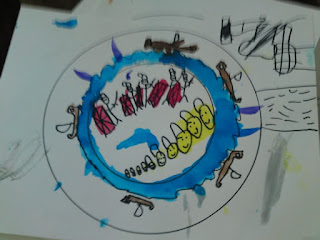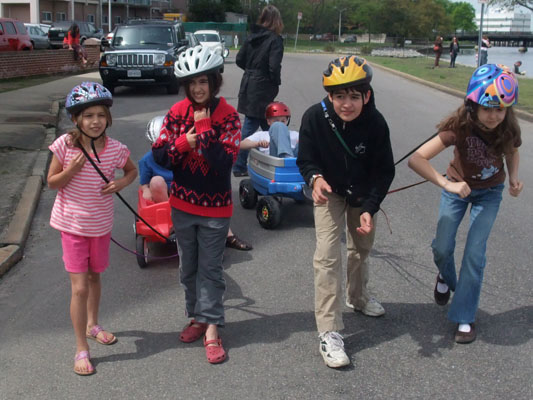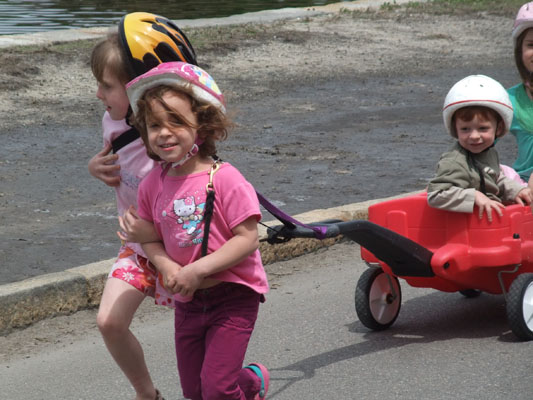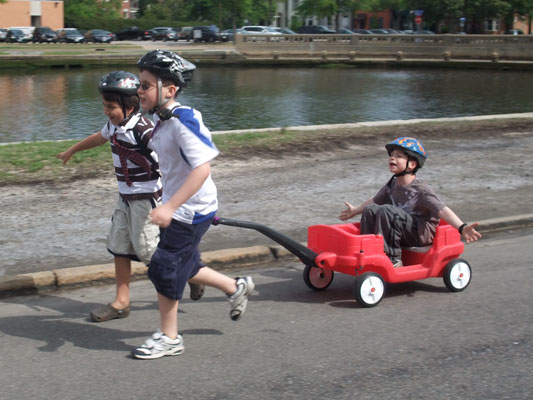 Welcome! This blog post is related to my Three Musketeers class at our homeschool co-op, Homeschool Out of the Box. We have an academic section, reading Richard Pevear's translation of the book, and an enrichment section, reading the Usborne Young Readers' abridgement of the story. For all lesson plans related to this class, click the Three Musketeers tag at the bottom of this post.
Welcome! This blog post is related to my Three Musketeers class at our homeschool co-op, Homeschool Out of the Box. We have an academic section, reading Richard Pevear's translation of the book, and an enrichment section, reading the Usborne Young Readers' abridgement of the story. For all lesson plans related to this class, click the Three Musketeers tag at the bottom of this post.HOMEWORK: Today we reviewed all our French and also learned how to ask someone their name and tell someone our names. We practiced on each other -- my, we're getting polite.
DISCUSSION: Our review of the reading comprehension from last week led us straight into our topic for today: Queen Anne. We learned her life story, and the background gave us a lot of insight into why she is found in the predicament Dumas creates for her. Learning about the real stories of historical figures that appear in this novel forces us to examine the way Dumas uses his material -- where he stretches the truth, where he invents, and where he uses real events to move his plot along. Queen Anne was a child bride, uprooted from her country and culture, and she was doing the best she could. It's my reading that Dumas treated her pretty well in the novel -- she seems like a victim trying to survive the royal turmoil. That may be a kind presentation.
In the junior class we talked about how in lots of movies (I used Shrek as an example, but lots of the kids had also seen The Princess Bride, which is another good one) a princess is being forced to marry someone she doesn't love. They all recognized this trope and agreed that arranged marriages were wrong and troubling. We talked about how usually in stories or movies, someone rescues the princess at the last minute and she doesn't have to marry the bad guy. In Queen Anne's life though, no one rescued her. No one busted down the doors of the church at the last minute, no one swept her away, no fairy godmother helped her, and she had to marry that guy she didn't know or love. So we can understand why she met someone later in her life that she did fall in love with, since her marriage was so unfair and not based on love. I think they get it.
ACTIVITIES: We had a wonderful time dancing and singing today, and in fact learned the very beginning step of what will become our minuet. The kids were great at this! They should practice at home -- any song in 3/4 meter would be appropriate for practicing. If they've forgotten the step, maybe the phrase "Step step step, tap tap tap" will help bring it back.
SKIT:
In the senior class, we acted out the arrest of M. Bonacieux:
Characters: D'Artagnan, Athos, Porthos, Aramis, Bonacieux, Guards
Action: D'Artagnan and the three musketeers are sitting around his house, just partying like it's 1632, when M. Bonacieux busts in and begs for their help in finding his kidnapped wife.
Bonacieux: Help! My wife's been kidnapped! And now they're after me.
D'Artagnan: We'll protect you, no matter what.
But oh no! Here come the guards to arrest M. Bonacieux. D'Artagnan not only refuses to help him, he encourages the guards to take him away!
Bonacieux: Help! Help! They've got me! Help me!
D'Artagnan: That's right, guards. Do your job. Take this man to the Bastille!
Porthos is outraged, but D'Artagnan explains that they can do more good for M. Bonacieux if they are not arrested with him, as they surely would be if they'd fought for his freedom.
In the junior class, the kids are a bit farther along in the plot, so we acted out the Duke's visit to the Louvre.
Characters: D'Artagnan, Constance, Duke of Buckingham, Queen, Scar-faced man, Cardinal Richelieu, King.
Action: We set up the room as best we could and used our imaginations, but we basically needed a doorway, a street, a bridge, the Queen's chamber, Cardinal Richelieu's office, and the King's office. When we started out, the Queen, the Cardinal, and the King were in their places, Constance was outside the door, the Duke of Buckingham was on the bridge, and D'Artagnan was inside the door. We also had a box of diamonds.
Constance (coming through the door): I escaped my captors!
D'Artagnan: How?
Constance: I tied my bedsheets together and went out the window!
D'Artagnan: Why were you kidnapped in the first place?
Constance: That's not my secret to tell. In fact, I have to go!
D'Artagnan: Let me go with you!
Constance: No, stay here. I have to go by myself.
Constance sets off on the streets of Paris and D'Artagnan sneaks behind. As she reaches the bridge, the Duke of Buckingham puts his arm around her and D'Artagnan protests.
D'Artagnan: Hey! What are you doing? Get your hands off her.
Constance: No, this is the Duke of Buckingham. I was sent here to meet him.
D'Artagnan: Oh, sorry! What can I do to help?
Duke: Follow us to the Louvre and protect us.
So the three of them set off to the Louvre with D'Artagnan guarding the rear. They enter the queen's chamber.
Duke: Oh you're so beautiful, so wonderful, blah blah blah.
Queen: Yes, yes, but we can never be together.
Duke: NOOOOOOooooooOOOOOOooooo!
Queen: Well, I'll give you a present to remember me by.
The queen gives the duke her diamonds. The scar-faced man, who had been hiding in a corner, snuck off to tell Cardinal Richelieu.
Scar-faced man: Hey, the queen just gave the Duke of Buckingham her diamonds!
Richelieu: Ah, that gives me an idea.
Richelieu goes to visit the king.
Richelieu: Hey, I have an idea -- why don't you have a party for the queen. She can wear the diamonds you gave her -- it'll be awesome!
King: That's a great idea.
The king goes to visit the queen.
King: Hey, I have an idea. I'm going to throw you a party. Make sure you wear your diamonds!
Queen: NOOOOoooOOOOOooo!!
If it seems complicated, consider we did this four times, mixing the parts around so everyone got a chance to be the part they most wanted to be. It was so much fun, and I was amazed with the kids, their awareness of the storyline, and their ability to take on these roles and really ham it up.
POETRY: Today we read "More Strong Than Time" by Victor Hugo so we could compare the love scene that Dumas wrote between the Queen and the Duke with Hugo's love poetry. The kids did a great job understanding this poem and were very good readers. I'm interested to see what they will think of some of the lines that Dumas gave the Duke compared to Hugo's images.
ASSIGNMENT: Here are the vocabulary words:
Indifferent
Discretion
Idle
Repudiating
Equivalent
Coquetry
Ransacked
Posterity
Calumny
Indulgence
And the reading comprehension questions:
D’Artagnan makes the same promise to Constance that the Duke of Buckingham makes to the queen. What is it?
What object does D’Artagnan keep noticing, and what initials are embroidered on it?
Why was Athos arrested?
What does the Duke of Buckingham tell D’Artagnan to do?
How many times has the Duke seen the Queen before?
What does he plan to do in order to see her more often?
I'd like them to consider if they'd let themselves get arrested for a friend, and think about Athos' sacrifice for D'Artagnan. Was it wise for him to be arrested, given how fierce the Cardinal was, and how unjust the justice system could be at the time?
















